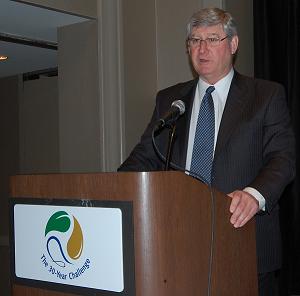A downstream portion of the Missouri River could join the upper part of the river in becoming a major power generator in this country.
This story from the Columbia (MO) Daily Tribune says a Massachusetts-based company is hoping to harness the hydrokinetic energy the river produces… without the massive dams seen in the Dakotas and Montana:
 Free Flow Power Corp. wants to plant thousands of small turbines underwater and use the rotation of turbine blades to produce clean energy. It has requested preliminary permits from the Federal Energy Regulatory Commission to study 25 regions of the river for the feasibility of generating electricity.
Free Flow Power Corp. wants to plant thousands of small turbines underwater and use the rotation of turbine blades to produce clean energy. It has requested preliminary permits from the Federal Energy Regulatory Commission to study 25 regions of the river for the feasibility of generating electricity.
Nationwide, the company has requested permits to study more than 100 spots along the Missouri, Mississippi and Ohio rivers.
The river segment nearest Columbia, a stretch of about 10.5 miles, is proposed as the site of as many as 6,300 Free Flow turbines that could generate enough electricity to power more than 100,000 homes.
Additional sites along the Missouri River could be home to hundreds of more turbines.
Regulatory challenges and characteristics of the river could be the biggest hurdles the company would have to clear to make the project a reality. The Federal Energy Regulatory Commission, the U.S. Fish and Wildlife Service and the Army Corps of Engineers… among others… would have to sign off on the project. And there’s lots of debris in the river that could damage the turbines, and, of course, ice in the winter could do some real damage unless the blades are far enough under water… a tough proposition in a river known for varying depths. But the upside is one turbine could replace 147 tons of coal a year.


 Biomass will be the fuel of choice for nearly half of the energy produced by a Connecticut power plant.
Biomass will be the fuel of choice for nearly half of the energy produced by a Connecticut power plant. New Jersey has its first retail biodiesel pump. Located in Maplewood, NJ, it’s operated by Woolley Fuel Company, and Sprague Energy Corp. is providing the biodiesel.
New Jersey has its first retail biodiesel pump. Located in Maplewood, NJ, it’s operated by Woolley Fuel Company, and Sprague Energy Corp. is providing the biodiesel. In October 2008, New Jersey’s Medford Township School District celebrated ten years of using B20, a 20 percent blend of biodiesel, in school buses. The retail pump will sell B5, a 5 percent blend of biodiesel. The company has plans to increase the blend to B20. Nationwide, there are more than 1,200 retail pumps selling biodiesel.
In October 2008, New Jersey’s Medford Township School District celebrated ten years of using B20, a 20 percent blend of biodiesel, in school buses. The retail pump will sell B5, a 5 percent blend of biodiesel. The company has plans to increase the blend to B20. Nationwide, there are more than 1,200 retail pumps selling biodiesel.


 For the second year in a row,
For the second year in a row,  GAM team member and driver Steve Zadig says, “For two years in a row, Iogen has been the only firm actively producing cellulosic ethanol and able to reach into its inventory to provide us with the volume we need – enabling us to ‘go green’ again.”
GAM team member and driver Steve Zadig says, “For two years in a row, Iogen has been the only firm actively producing cellulosic ethanol and able to reach into its inventory to provide us with the volume we need – enabling us to ‘go green’ again.” The 2008 Phase II of Renewable Energy in America National Policy Forum featured Policy recommendations on renewable energy, energy efficiency, sustainable development, the environment and green jobs.
The 2008 Phase II of Renewable Energy in America National Policy Forum featured Policy recommendations on renewable energy, energy efficiency, sustainable development, the environment and green jobs.


 Rural America’s infrastructure challenges cut to the heart of the six challenges outlined during this morning’s session of the Farm Foundation’s Food and Agriculture Policy Summit being held in Washington, D.C.
Rural America’s infrastructure challenges cut to the heart of the six challenges outlined during this morning’s session of the Farm Foundation’s Food and Agriculture Policy Summit being held in Washington, D.C.  “The engineers will tell you [the pavements] look OK on the surface, but underneath it is starting to crumble.” Griffin says by the time the damage is clearly noticeable, it costs two to three times as opposed to normal maintenance and repair.
“The engineers will tell you [the pavements] look OK on the surface, but underneath it is starting to crumble.” Griffin says by the time the damage is clearly noticeable, it costs two to three times as opposed to normal maintenance and repair. The world’s population will grow by 33 percent by the year 2040, but the amount of farmland to feed and fuel that growing demand won’t have to grow by that same one-third… that’s what attendees at the Farm Foundation’s Food and Agriculture Policy Summit in Washington, D.C. heard this morning.
The world’s population will grow by 33 percent by the year 2040, but the amount of farmland to feed and fuel that growing demand won’t have to grow by that same one-third… that’s what attendees at the Farm Foundation’s Food and Agriculture Policy Summit in Washington, D.C. heard this morning. “Agriculture’s role is not one of conflict between food or fuel. It is one that is quite compatible. Producing more food results in more fuel being produced as well.”
“Agriculture’s role is not one of conflict between food or fuel. It is one that is quite compatible. Producing more food results in more fuel being produced as well.”